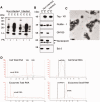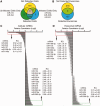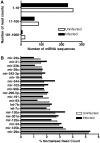Small RNA deep sequencing reveals a distinct miRNA signature released in exosomes from prion-infected neuronal cells
- PMID: 22965126
- PMCID: PMC3505968
- DOI: 10.1093/nar/gks832
Small RNA deep sequencing reveals a distinct miRNA signature released in exosomes from prion-infected neuronal cells
Abstract
Prion diseases are transmissible neurodegenerative disorders affecting both humans and animals. The cellular prion protein, PrP(C), and the abnormal infectious form, PrP(Sc), are found associated with exosomes, which are small 50-130 nm vesicles released from cells. Exosomes also contain microRNAs (miRNAs), a class of non-coding RNA, and have been utilized to identify miRNA signatures for diagnosis of disease. While some miRNAs are deregulated in prion-infected brain tissue, the role of miRNA in circulating exosomes released during prion disease is unknown. Here, we investigated the miRNA profile in exosomes released from prion-infected neuronal cells. We performed the first small RNA deep sequencing study of exosomes and demonstrated that neuronal exosomes contain a diverse range of RNA species including retroviral RNA repeat regions, messenger RNA fragments, transfer RNA fragments, non-coding RNA, small nuclear RNA, small nucleolar RNA, small cytoplasmic RNA, silencing RNA as well as known and novel candidate miRNA. Significantly, we show that exosomes released by prion-infected neuronal cells have increased let-7b, let-7i, miR-128a, miR-21, miR-222, miR-29b, miR-342-3p and miR-424 levels with decreased miR-146 a levels compared to non-infected exosomes. Overall, these results demonstrate that circulating exosomes released during prion infection have a distinct miRNA signature that can be utilized for diagnosis and understanding pathogenic mechanisms in prion disease.
Figures





References
-
- Prusiner SB. Novel proteinaceous infectious particles cause scrapie. Science. 1982;216:136–144. - PubMed
-
- Aguzzi A, Heikenwalder M. Pathogenesis of prion diseases: current status and future outlook. Nat. Rev. Microbiol. 2006;4:765–775. - PubMed
-
- Thery C, Zitvogel L, Amigorena S. Exosomes: composition, biogenesis and function. Nat. Rev. Immunol. 2002;2:569–579. - PubMed
-
- Vella LJ, Sharples RA, Lawson VA, Masters CL, Cappai R, Hill AF. Packaging of prions into exosomes is associated with a novel pathway of PrP processing. J. Pathol. 2007;211:582–590. - PubMed
Publication types
MeSH terms
Substances
LinkOut - more resources
Full Text Sources
Other Literature Sources
Research Materials

